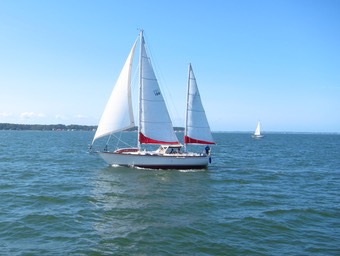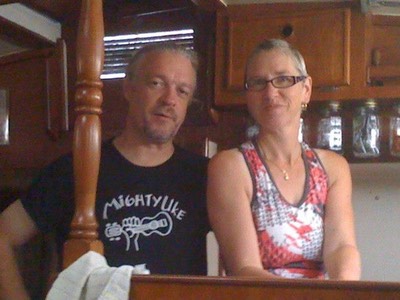Travel 2020-2021
Bedding
The Whitby sleeps 6 (sometimes 7, depending on your saloon.) It seems like a lot of owners live in the aft cabin, and use the saloon and V-berth for guests.
The aft cabin is designed to have two widely-separated bunks.
A lot of couples sleep athwartship. One person is aft — wedged under the deck — and the other person forward. It can be awkward.
We’re opting for sleeping on the isolated sides of the berth. This means CA is building mattress pads for each side.

And the means all the sewing machines are in use. A little tiny thing that barely weighs five pounds and does one kind of stitch. And the SailRite LZ-1 which weighs a ton (45 pounds) and can sew through layers of epoxy-impregnated Dacron.
Since we moved aboard (almost ten years ago) we’ve always had some kind of bedding in the back. Even when we moved ashore five years ago, we spend weekends on the boat, and left the bedding all setup.
When we moved to Nevada, we stood all the cushions and mattresses on their sides. There was bedding in the aft cabin. And all the fenders. And coils of dock line.

Since CA was building mattress pads, all the bedding was stripped out of the aft cabin. This was odd look, for us, to see nothing there but the cushions.
It was weirdly empty.
I think the last time it was empty was December of 2009.
In this picture, the space behind CA is the shadowy under-deck area where I used to sleep. It’s low. And dark.
I did approximately nothing this weekend. I’m — nominally — working on replacing a mast step. Which means unscrewing six Phillips-head screws. It’s a brutal slog with penetrating oil, rubber-bands over the top of the Phillips screwdriver, pounding in a square drive bit. Eventually, I have to resort to the Vise-Grip® curved jaw pliers. I’m reluctant, but everything else has failed. I’ve resorted to shopping rather than panic about the machine screw stuck in the mast.
When I finally get the screws out, the replacement step is aluminum. The mast is aluminum. It seems like four big Avdel AACQ-08-08 Q Rivets would be the right thing to hold the step on. This means buying an F drill bit. What size is F? How the F do I know? It’s the size for these rivets. The TiN finish is recommended for a drill bit to cut metal.
(I’d prefer the weatherproof Gesipa RV6601-8-8 rivets, but I’m having trouble buying less than 1,000 of them. I suppose I could buy them and then sell the excess 990 on eBay.)
Less Work — More Doing Nothing
We use Trello (https://trello.com) to track a lot of the jobs on Red Ranger. We also use Toodledo (https://www.toodledo.com). Trello is really good for complex one-time tasks, prioritizing, assigning, etc. Tooled is really good for recurring tasks. Trello requires an internet connection, Toodledo is a mobile app that synchronizes through the web.
And some days, we lay around in the cockpit and talk about what we’re going to do. Someday.
(Cue up Cat Empire “The Car Song”. Someday. I’ll buy and old car. Someday. I’ll get that car to start. Someday. I’ll learn how to drive, too.)
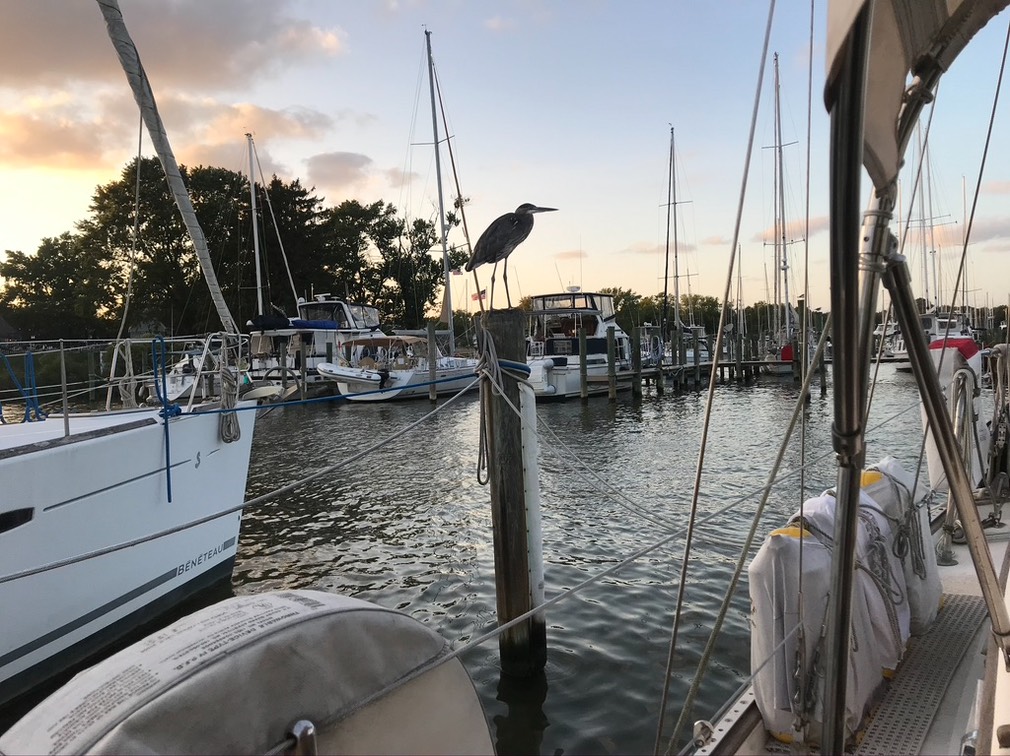
Tasks seem to fall into five categories.
Blue Heron. Easy. There it was. It’s name is “George."
Epic. Things like encapsulating the rub rail or rebuilding the sails or installing new electronics or rerouting the deck drains.

Woodwork. Multipart jobs that can’t be done in a single weekend. Applying Epifanes to the hatchboards. This takes days and days to apply seven coats of polyurethane. And. It’s hard to do both of them at once because it seems like it would be awkward to go in or out until it’s hardened enough that you can touch it to slide it open. And we spilled ammonia on the cabin sole — it needs to be cleaned down to a consistent color and then a satin-finish urethane applied.
Minor. Rewriting the connectors on the solar panels. Adding a 12V socket in the aft cabin so I can replace the fan that’s there with a quieter one. Replacing the collection of foredeck panels with two 55W GoPower! panels. And replacing all the MC4 connectors with the correct gender connectors. (I did them all exactly backwards before. Sigh.)
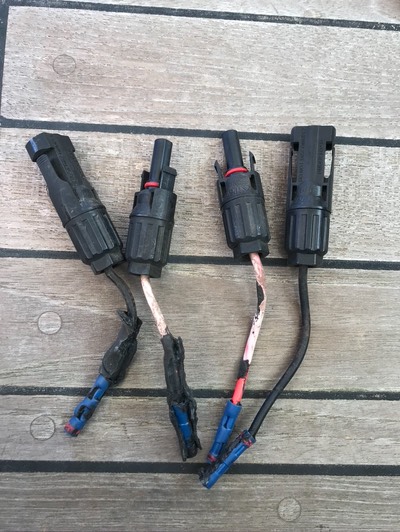
Here are the old connectors that I removed. You can see they’re proper MC4 at one end. The “white” wire was originally red. The red wires are on the wrong gender connector. The outside two are male and usually have positive current flow. The inner two are female and should have been ground.
CA has a dozen of these “minor” jobs, maybe more. We need new cloth covers for the windlass and the helm station. We *should* have cloth covers on all the winches. We need proper covers for the jerryjugs of spare fuel we keep on deck. We need a place to keep sunglasses. We need better bugscreens for the companionways. A lot of sewing. Each small. Each super-helpful.
Annoying. These are jobs I’d rather contemplate than do. Here are a few:
- Replacing the valves in the deck wash down/bilge pump system. It appears I didn’t use proper bronze; the valves I put in many years ago are looking corroded and sketchy. I have bronze valves ready to go. I just have to actually do it.
- Replacing one mast step with a folding mast step. This involves freeing six stuck stainless steel screws (say that six times fast.) Two have moved. Four are soaking in penetrating oil. The “rubber band” trick worked for one. I hope it works for another of the hard to access screws. This can’t simply be attacked as a job. It has to be done in stages. It requires a lot of patience.
- Sanding and teak-oiling the handrails and eyebrow wood all around Red Ranger. This doesn’t count as woodwork because there’s little aesthetic concern to this. It’s not like the spilled ammonia on the cabin sole. It’s just a lot of hunkering down, light sanding, and brushing on teak oil.
This weekend, we did very little. I’m gaining confidence in applying Epifanes, but, it’s still a terror-filled nightmare. CA reminds me I can always sand it out and try again.
Labor Day
Instead of taking a break to honor the Labor Movement, we worked.
Some of it was wildly successful. CA washed down the entire deck. It’s amazing how much grime accumulates when you’re not actively using the boat. CA uses ammonia once each year to gently wash the teak toe-rails. We’ve heard vinegar recommended, also, and may switch to that.
We’re going to start using “Teak Oil” (one of those specialized Tung oil preparations) on the grab-rails and whatnot. It’s very easy to apply and seems to help the wood. It’s a quick sand-paper and sponge-brush operation. Not half as demanding as Epifanes or other urethane preparations. Much nicer-looking than the old Cetol that we peeled off because we didn’t like the look.

I replaced part of the outboard bracket.
It’s not easy to see, but there are shiny, new metal parts in and among the old rusty parts and the flaking blue-paint of the original parts.
At the bottom of the picture, there’s a horizontal bar with a rusty hole in the middle and two Phillips-head screws.
The metal is slick with penetrating oil.
I used a dental pick to scrape around the screws to make some avenues for the oil to work it’s way into the metal bits.
And still, the screws were immovable.
A wrench and a lot of downward pressure and I managed to rounded out the slots until no screwdriver will stay in them.
The “bolt extractor” drill bits — https://www.richtoolsystems.com/25-Pc-Screw-and-Bolt-Extractor-Drill-Guide-Set_p_594.html — didn’t help. At this point, the left screw has half of a broken bolt extractor jammed down deep inside it. I can’t get another smaller extractor into the original extractor, and I can’t get a screwdriver into the original bold, either.
Sigh.
I think I can use a Dremel to cut parts of the bracket away, then cut a slot across the top of the bolt, and try a big slotted drag link socket —https://www.amazon.com/Craftsman-9-34299-Drag-Socket-4-Piece/dp/B007KHDBLG — to see if I can move it. Sadly, the Dremel is not on the boat. So. Sigh. Maybe next weekend.
It’s time to replace the on-deck solar panels. The 7-year-old panels have started to look shabby. I’m pretty sure they’re still working, but I haven’t checked. Semi-flexible panels are only good for about five years.
I’m looking at the GoPower! 55W panels. At 11″ × 42″, they between coaming and dorade box comfortably. Replacing the panels seems to be part and parcel of fixing the sketchy wiring job I did. Simplifying the three foredeck panels to two and expanding the output from 63W to 110W is a huge victory.
Cleaning and Sailing — Part 2
Yes, we have left the dock. Here’s the cockpit, heeled over in 10-15 kt of wind. Beam Reaching down Herring Bay.

And here’s the view out on the water.
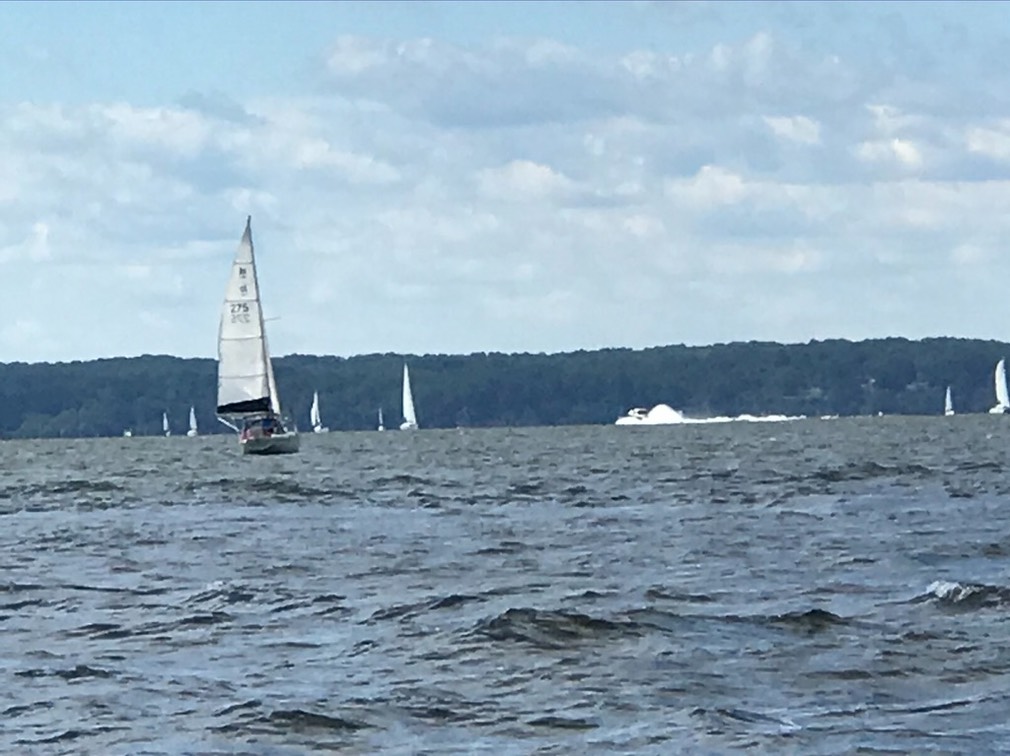
Sun. Wind. Boats.
We got our reefing lines and lazy jacks squared away. These are hard to finagle into place when bending the sail on. After hoisting it, though, it’s easier to make sure everything is in its place.
I have a tendency to overtrim. We were looking at the B&G sail steer display and noting the immense amount of leeway it shows when comparing the boat’s orientation with it’s heading and the course we’re actually sailing.
Also. We’ve decided on a policy of going below obstacles. This seems to be a lot smarter than trying to pinch up into the wind to go above something. Red Ranger just doesn’t point well and we need to factor that into our decision-making under sail.
Some of the confusion is an effect of the location of the compass used by the autopilot. It’s on the starboard side of the boat. Being off-center puts a bit of bias into the system that’s a little hard to completely factor out.
If I was smarter, I’d measure the distance from center line to compass and do the real math to figure out the offset. (Just guessing based on my recollection of the size of the aft cabin, and guessing at the distance to the mast, it looks like 9° to 14°.)
